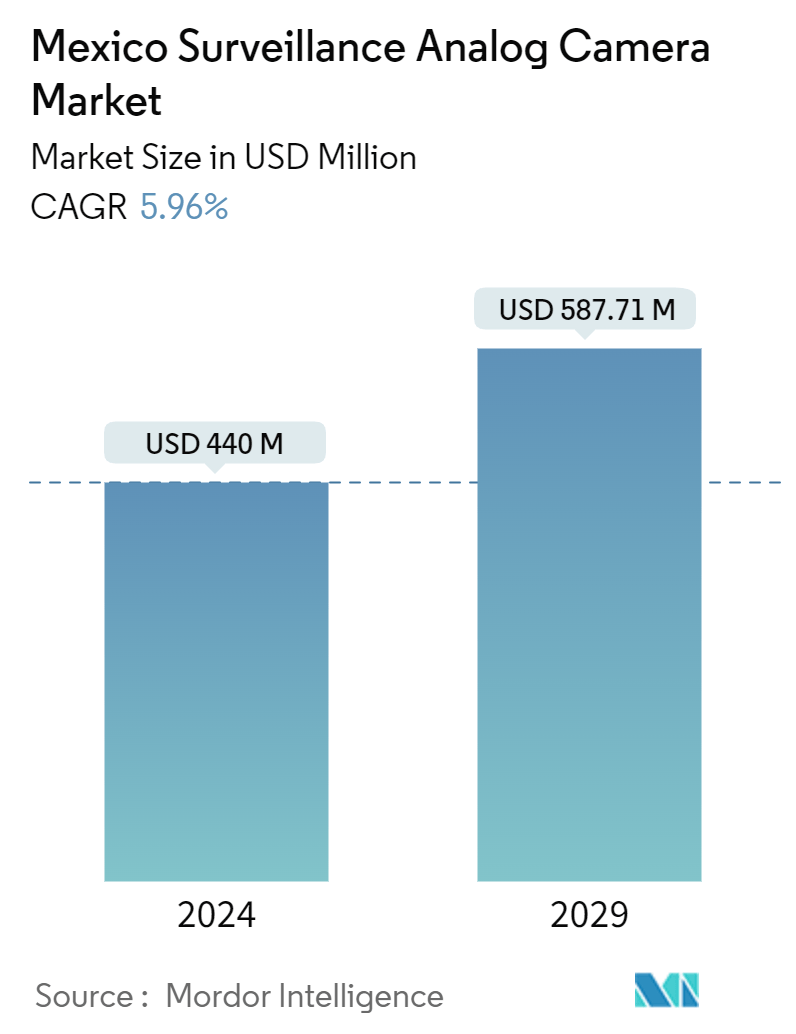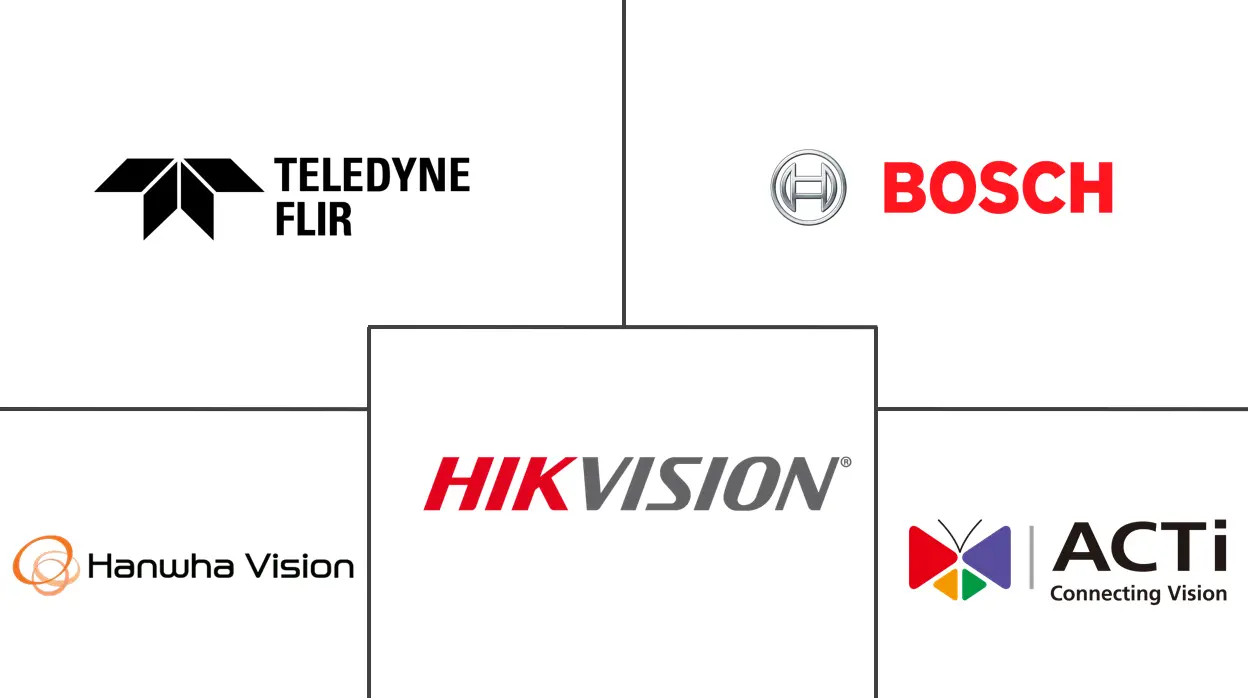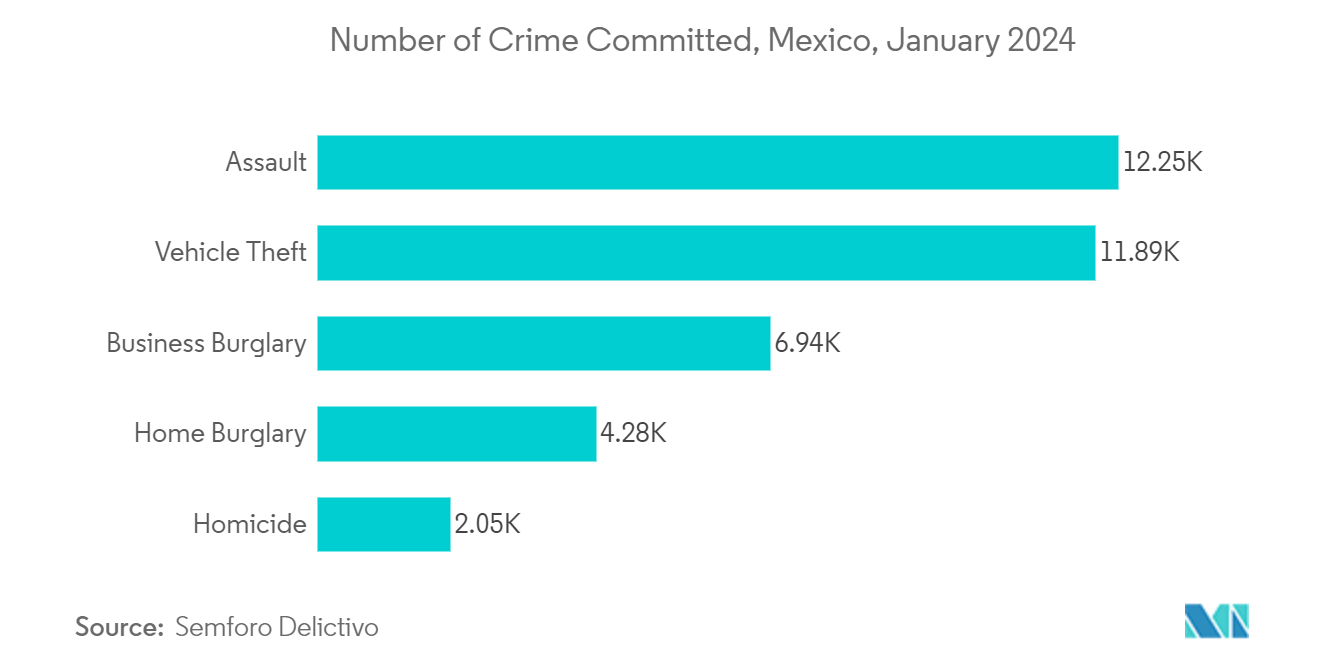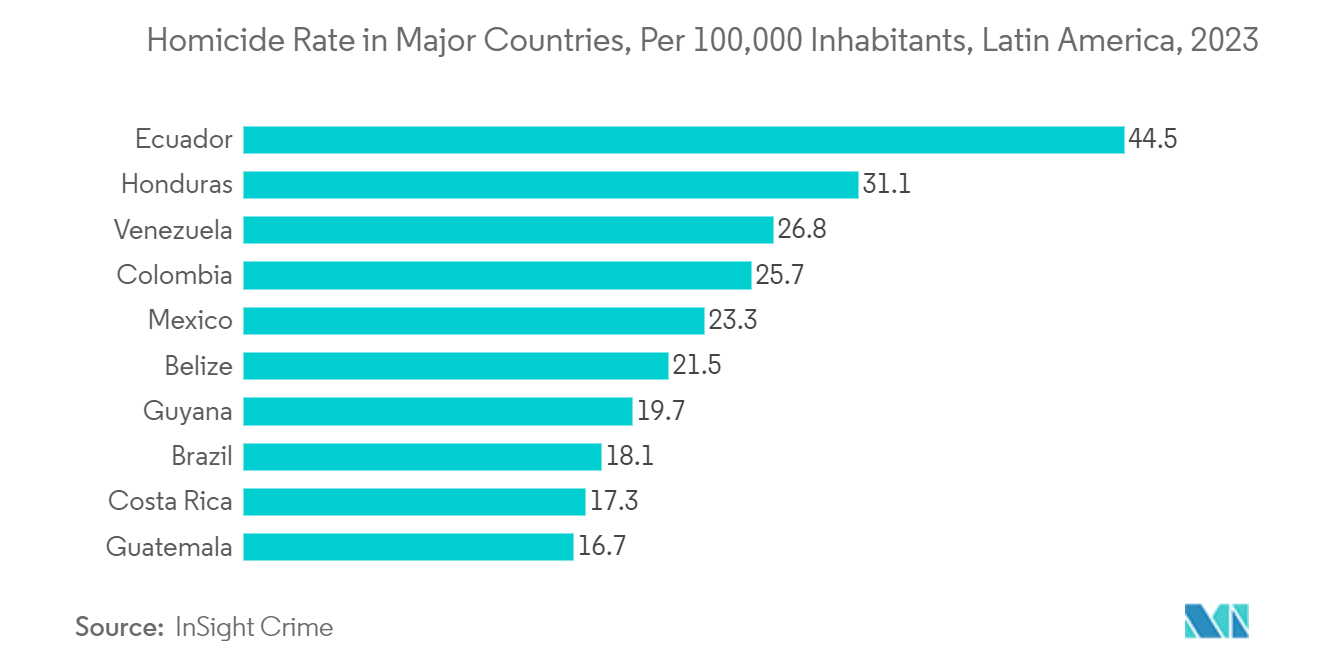Mexico Surveillance Analog Camera Market Size

| Study Period | 2019 - 2029 |
| Base Year For Estimation | 2023 |
| Market Size (2024) | USD 440 Million |
| Market Size (2029) | USD 587.71 Million |
| CAGR (2024 - 2029) | 5.96 % |
| Market Concentration | Low |
Major Players
*Disclaimer: Major Players sorted in no particular order |
Mexico Surveillance Analog Camera Market Analysis
The Mexico Surveillance Analog Camera Market size is estimated at USD 440 million in 2024, and is expected to reach USD 587.71 million by 2029, growing at a CAGR of 5.96% during the forecast period (2024-2029).
- The demand for analog surveillance cameras in Mexico is expected to grow robustly during the forecast period. Several factors influence the developed market in Mexico, including the higher price sensitivity among various consumer segments. The growing investment in security and surveillance solutions by enterprises operating across different sectors also supports the market's growth.
- Urbanization in Mexico has heightened concerns about crime and public safety. The urbanization rate has been consistently rising and has reached above 80%. In response, governments and the private sector are ramping up investments in surveillance systems, fueling the demand for cost-effective analog cameras. Mexico faces significant challenges with crime, particularly in urban areas. High rates of theft, violent crime, and drug-related violence have spurred demand for effective and affordable security solutions.
- According to data published by the National Public Security System, Mexico registered more than 40,000 homicides in 2023, marking increasing levels of dangerous crime across the country. The government has deployed the National Guard to various regions to enhance security and support local law enforcement. This measure aims to provide a more robust response to criminal activities. These efforts aim to curb crime and improve public safety, creating a favorable ecosystem for the growth of the market studied.
- Many Mexican municipalities increasingly adopt citywide surveillance setups to monitor public areas, transport nodes, and vital infrastructure. Notably, in 2024, Mexico City announced a significant USD 1.13 billion investment in infrastructure, with a preference for analog cameras due to their cost-effectiveness in large-scale deployments.
- With the rising adoption of cost-effective surveillance solutions by small and medium-sized enterprises (SMEs) in Mexico, the demand for analog surveillance cameras is set to surge. This is especially significant as a majority of businesses in Mexico are SMEs, and the affordability of these cameras enhances their appeal. In addition, driven by mounting worries about burglary, vehicle theft, and homicide, homeowners and residential complexes are pivoting toward analog cameras to bolster their security measures.
- While analog cameras have made progress, they still lag behind IP cameras in advanced features. The adoption of IP cameras is surging, especially due to their advanced analytics and facial recognition capabilities, which are proving invaluable to law enforcement efforts. Yet, due to their affordability, convenience, and reliability, analog cameras are set to maintain their importance in these systems.
Mexico Surveillance Analog Camera Market Trends
Cost Effectiveness and Affordability of Analog Cameras are Driving their Demand
- In Mexico, the analog camera market for surveillance thrives on its cost-effectiveness and affordability. These attributes significantly influence purchase decisions across various sectors, including government, public safety, commercial, and residential applications. Mexico's municipal governments, known for their stringent budget limitations, often find investing in comprehensive surveillance setups challenging. Analog cameras are the preferred option because they are more budget-friendly upfront than their IP counterparts. This financial edge empowers municipalities to broaden their surveillance reach.
- Retail businesses in Mexico grapple with theft and inventory losses. Analog cameras are cost-effective for monitoring store interiors, entry points, and checkout areas. This heightened surveillance aids in curbing shrinkage and bolstering loss prevention efforts, which is especially significant in a country boasting over 4 million SMEs.
- According to data published by INEGI for the first quarter of 2024, about 61% of the adult population in Mexico did not feel safe in the state where they lived. Furthermore, statistics from Semaforo Delictivo highlight Mexico's crime landscape: 11,887 vehicle thefts, 6,935 business burglaries, and 4,282 home break-ins in January alone of 2024. Such trends are anticipated to create a favorable ecosystem for the growth of the market studied.
- Retailers and small businesses, often constrained by finances, find analog cameras notably affordable. As Mexico witnesses a surge in retail outlets, the demand for surveillance cameras is set to rise, painting a positive growth trajectory for the market. Moreover, as homeowners and residential complexes prioritize property security, the appeal of analog cameras lies in their affordability. These cameras present a budget-friendly means to monitor entrances, perimeters, and shared spaces, offering peace of mind without a hefty price tag.

Government Sector Witnessing Growth in Demand
- Mexico's national public security strategy aims to reduce crime rates, particularly in urban areas plagued with high levels of violence and criminal activities. The country hosts a few of the world's most dangerous cities, with cities like Celaya topping the charts. The homicide rate in Mexico is one of the highest in Latin America, with 23.3 homicides per 100,000 inhabitants.
- Major cities in Mexico, like Guadalajara and Mexico City, have rolled out extensive surveillance networks to bolster public safety. These networks predominantly utilize analog cameras, prized for their cost-effectiveness and swift deployment. They enable broad coverage of high-crime zones, transit points, and public spaces.
- Mexico serves as a poignant example of the toll violence takes on a nation. Beyond claiming lives, violence disrupts daily routines and inflicts severe blows on the economy. A pervasive sense of insecurity hovers over Mexicans, who not only fear homicide but also grapple with prevalent crimes like assault and rape. INEGI reports that the cost of crime in Mexico has soared, surpassing USD 10 billion.
- Mexico's smart city drive has seen its cities incorporate cutting-edge urban management technologies. Analog cameras, pivotal in this initiative, offer cost-effective surveillance, bolstering urban safety and governance.
- With a focus on border security, Mexico has ramped up its efforts, especially in regions prone to illegal crossings and smuggling. Surveillance tools, including analog cameras, are strategically placed along the borders, aiding in monitoring and bolstering border patrol operations. In addition, collaborative security efforts with the United States entail deploying surveillance systems along the shared border.

Mexico Surveillance Analog Camera Industry Overview
The Mexican surveillance analog camera market is fragmented, with major international players competing by offering technologically advanced products. The market features a wide range of manufacturers offering various technologies and solutions. Many companies compete in the market, offering various surveillance camera types and integration services. Some key market players include Teledyne FLIR, Hikvision, Bosch, and Hanwha Vision.
- May 2024: Bosch introduced its 3100i camera series, tailored for heightened security needs in pivotal locations like government buildings, airports, and educational institutions. The FLEXIDOME 3100i, a recent addition to this lineup, emphasizes robust security alongside advanced video analytics and data protection. This camera series includes an indoor variant, available both with and without IR illumination, enhancing its adaptability to diverse project needs. The IR illumination enables clear coverage of up to 30 m (98 ft) in low-light conditions, while the integrated varifocal lenses ensure crisp, detailed imagery with customizable viewing angles.
Mexico Surveillance Analog Camera Market Leaders
-
Teledyne FLIR LLC
-
Hanwha Vision America
-
Hangzhou Hikvision Digital Technology Co., Ltd.
-
Bosch Sicherheitssysteme GmbH
-
ACTi Corporation
*Disclaimer: Major Players sorted in no particular order

Mexico Surveillance Analog Camera Market News
- April 2024: Hikvision unveiled its latest Turbo HD 8.0, the newest iteration of its analog security product line. This upgraded version boasts four key features, namely real-time communication, 180-degree video coverage, enhanced night vision capabilities, and a more compact design. The dual-lens camera, a highlight of this release, leverages proprietary image-stitching technology to seamlessly deliver vivid, colorful 180-degree images, day or night. Due to its large F1.0 aperture and high-sensitivity sensors, these images maintain their vibrancy even in low-light conditions. Moreover, the camera's new compact design enhances its discretion, making it an ideal fit for small and medium businesses.
- October 2023: Hikvision, a prominent vendor in the Mexican surveillance camera market, launched the ColorVu Fixed Turret (DS-2CE70DF0T-MF) and Bullet (DS-2CE10DF0T-F) cameras, featuring an F1.0 aperture. According to the company, these 2 MP analog cameras offer continuous, high-quality, full-color imaging, support HD over analog cabling for easy upgrades, and feature 3D digital noise reduction (DNR) technology. The F1.0 aperture on the ColorVu cameras ensures vivid colors even in low-light settings.
Mexico Surveillance Analog Camera Market Report - Table of Contents
1. INTRODUCTION
- 1.1 Study Assumptions and Market Definition
- 1.2 Scope of the Study
2. RESEARCH METHODOLOGY
3. EXECUTIVE SUMMARY
4. MARKET INSIGHTS
- 4.1 Market Overview
-
4.2 Industry Attractiveness - Porter's Five Forces Analysis
- 4.2.1 Bargaining Power of Suppliers
- 4.2.2 Bargaining Power of Consumers
- 4.2.3 Threat of New Entrants
- 4.2.4 Threat of Substitutes
- 4.2.5 Intensity of Competitive Rivalry
- 4.3 An Assessment of the Impact of Macroeconomic Trends on the Market
5. MARKET DYNAMICS
-
5.1 Market Drivers
- 5.1.1 Cost Effectiveness and Affordability
- 5.1.2 Efforts Being Made by Government and Law Authorities to Leverage Technology to Reduce Crime
-
5.2 Market Restraints
- 5.2.1 Technological Limitation
6. MARKET SEGMENTATION
-
6.1 By End-user Industry
- 6.1.1 Government
- 6.1.2 Banking
- 6.1.3 Healthcare
- 6.1.4 Transportation and Logistics
- 6.1.5 Industrial
- 6.1.6 Other End-user Industries
7. COMPETITIVE LANDSCAPE
-
7.1 Company Profiles*
- 7.1.1 Teledyne FLIR LLC
- 7.1.2 Hangzhou Hikvision Digital Technology Co. Ltd
- 7.1.3 Hanwha Vision America
- 7.1.4 ACTi Corporation
- 7.1.5 Bosch Sicherheitssysteme GmbH
- 7.1.6 Pelco
- 7.1.7 Zhejiang Uniview Technologies Co. Ltd
- 7.1.8 IDIS Ltd
- 7.1.9 Honeywell International Inc.
- 7.1.10 Panasonic Corporation
- 7.1.11 CP Plus
8. INVESTMENT ANALYSIS
9. FUTURE OF THE MARKET
** Subject To AvailablityMexico Surveillance Analog Camera Industry Segmentation
An analog surveillance camera records video in an analog format and usually sends signals via coaxial cables to a recording device or monitor. While they are budget-friendly for fundamental security, analog cameras lag behind digital and IP counterparts in resolution and advanced technology integration.
The study tracks the revenue accrued through selling surveillance analog camera products by various players operating in Mexico as the baseline for market estimations. The study also tracks the key market parameters, underlying growth influencers, and major vendors operating in the industry, which supports the market estimations and growth rates over the forecast period. The study further analyses the overall impact of macroeconomic factors on the market.
The Mexican surveillance analog camera market is segmented by end-user industry (government, banking, healthcare, transportation and logistics, industrial, and other end-user industries). The market sizes and forecasts are provided in terms of value in USD for all the above-mentioned segments.
| By End-user Industry | Government |
| Banking | |
| Healthcare | |
| Transportation and Logistics | |
| Industrial | |
| Other End-user Industries |
Mexico Surveillance Analog Camera Market Research FAQs
How big is the Mexico Surveillance Analog Camera Market?
The Mexico Surveillance Analog Camera Market size is expected to reach USD 440 million in 2024 and grow at a CAGR of 5.96% to reach USD 587.71 million by 2029.
What is the current Mexico Surveillance Analog Camera Market size?
In 2024, the Mexico Surveillance Analog Camera Market size is expected to reach USD 440 million.
Who are the key players in Mexico Surveillance Analog Camera Market?
Teledyne FLIR LLC, Hanwha Vision America, Hangzhou Hikvision Digital Technology Co., Ltd., Bosch Sicherheitssysteme GmbH and ACTi Corporation are the major companies operating in the Mexico Surveillance Analog Camera Market.
What years does this Mexico Surveillance Analog Camera Market cover, and what was the market size in 2023?
In 2023, the Mexico Surveillance Analog Camera Market size was estimated at USD 413.78 million. The report covers the Mexico Surveillance Analog Camera Market historical market size for years: 2019, 2020, 2021, 2022 and 2023. The report also forecasts the Mexico Surveillance Analog Camera Market size for years: 2024, 2025, 2026, 2027, 2028 and 2029.
Mexico Surveillance Analog Camera Industry Report
Statistics for the 2024 Mexico Surveillance Analog Camera market share, size and revenue growth rate, created by Mordor Intelligence™ Industry Reports. Mexico Surveillance Analog Camera analysis includes a market forecast outlook for 2024 to 2029 and historical overview. Get a sample of this industry analysis as a free report PDF download.



